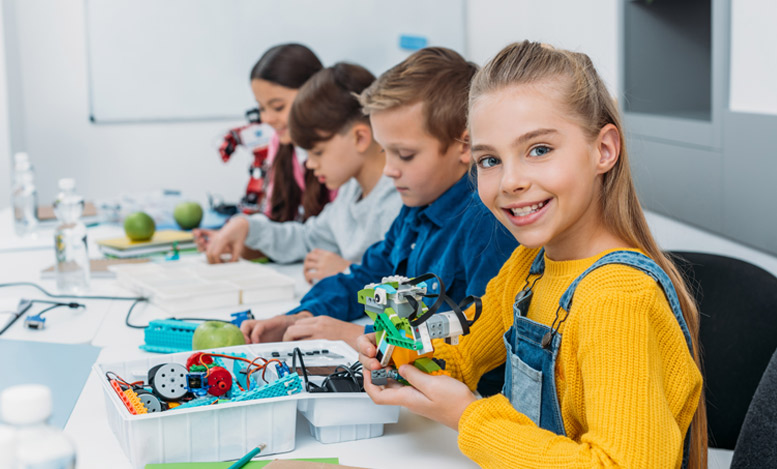Makerspaces—also known as hackerspaces, creativity labs, and tech shops—have been a hot trend in the K–12 educational space for the last few years. The hands-on approach to STEM education is helping educators foster a deeper passion for science, technology, and mathematics.
Throughout the educational landscape, a number of trends are taking hold and driving the next stage of evolution for makerspace creation and growth. Here’s what educators and administrators need to know about how a creativity lab could benefit their students.
Educational Hackerspaces Are Seeing Deeper Community Engagement
Makerspaces offer schools the opportunity to go beyond books and lectures, and into hands-on learning that helps students build hands-on STEM skills. For example, students may get direct training in the latest cybersecurity and coding techniques in their school’s hackerspace. In many ways, today’s educational tech shops reflect the larger societal interest in hacking, inventing, and exploring the potential of emerging technologies.
As a result, makerspaces are seeing more involvement from parents, community members, and organizations through donations, teaching, and other forms of support. In many ways, this engagement enhances the educational experiences makerspaces can provide students and turns a makerspace into a nexus between the education system and the larger interested community.
Creativity Labs Evolve to Support a Wide Range of Technologies and Projects
There’s no single approach to today’s creativity labs and makerspaces. Newsweek describes High Tech High, an initiative in San Diego: “With compact disc chandeliers, a piano whose glass exterior reveals how it works, birds and whales and geometric shapes soaring overhead, a ring of bicycle wheels the size of a clock tower spinning constantly through an intricate pulley system, and dozens of other mechanisms, paintings, sculptures, and projects ornamenting every hall and classroom, High Tech High looks something like a cross between a science center and a museum of modern art, where the only thing more jaw-dropping than what’s on display is the fact that all of it is created by kids in grades K–12.”
In the classroom, makerspaces are helping educators and schools connect with students. As one teacher writes for Getting Smart magazine, “An effective makerspace is more than fancy gadgets and a focus on STEM. In fact, I believe there’s no specific formula to follow when implementing one. One of the goals of any makerspace should be to instill the maker mindset in students through a series of creative experiences, while simultaneously building 21st-century skills.”
Related: Keeping Girls Interested in STEAM in Middle School and Beyond
They’re Integrated Across the Curriculum
As THE Journal notes, “Policymakers and administrators, meanwhile, want to make sure the spaces and resources are well utilized and are providing as much educational bang for the buck as possible. Luckily, integrating makerspaces throughout the curriculum is fairly easy with the right frame of mind.” Today’s fab labs have adapted to support a wider range of programs, courses, and subject areas. In many cases, this has also supported interdisciplinary opportunities. For example, students might use 3D printers to create props or set pieces that are used in a theater or literature class, providing hands-on opportunities for learning and deeper engagement.
More Districts Are Launching Makerspaces
K–12 educational leaders, from administrators to teachers, are increasingly taking the plunge and exploring how a makerspace fits into their school district. If you’re thinking about launching a hackerspace or creativity lab, consider the following:
- Design your makerspace for your goals. Every school, student population, and initiative has different objectives. Prioritizing these helps you create a space that meets your needs according to MIT’s Edgerton Center.
- It’s okay to start small. Consider running a pilot program to show the idea can be successful, and then make larger investments as support and interest grows.
- Be open to different kinds of creativity labs. MIT’s Edgerton Center notes that a makerspace can be a portable cart, a dedicated van, dedicated workshops, space in a library or community center, or an entire specialized space.
- Technology can help. Over time, hackerspaces often invest in everything from dedicated computers for coding to 3D printers. Work with an experienced educational technology provider to cost-effectively meet the technology needs of the space you’re developing.
- Don’t overlook the importance of culture—especially one that supports experimentation. Get clear on the culture you want to create early. In one of the first national studies on K–12 makerspaces, researchers from Drexel University concluded, “The culture of a makerspace has a direct impact on student learning. Rather than choosing equipment or specific projects, designers of new makerspaces should first consider the kind of learning culture they seek to create for their students.”
- The researchers from Drexel also concluded that a wide range of students benefit from makerspaces. Their conclusion: recruit instructors and students with inclusivity in mind.
Sustainability Becomes an Important Focus
As educational fab labs become more established, educators are increasingly focused on sustainability. One educator notes in Worlds of Learning, “What’s next? Sustainability. That requires proper planning. I am not just talking about the initial planning that is vital to creating the right makerspace for your school. This planning is for the future, and it requires looking back.”
That focus involves aligning makerspaces with the school’s top priorities, getting the right stakeholders involved in management, and—most importantly—thinking about long-term funding. If you’re interested in launching a makerspace or creativity lab in your district, don’t overlook the role of grants to help. State, federal, and private grants may be available to help school districts access technology, software, space, and other resources needed to build a makerspace.Preparing the next generation of students for the 21st century—and the careers that will be central and we can’t even imagine yet—is a significant challenge. STEM curriculum is at the heart of future-focused learning. Schools are embracing the possibilities of makerspaces to help bring science and technology to life while cultivating a variety of skills to help prepare students for future employment opportunities. Explore how a creativity lab can help your educators inspire students.


